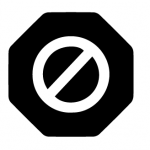Stop
The first move is the simplest. Stop reminds you of two things.
First, when you find an article and start to read it — Stop. Ask yourself whether you know the journal, website, Facebook page, Twitter account, etc…where the information is posted. What is their reputation? Did you find the article in a library database (which is vetted)? Is the website reputable (e.g. American Heart Association vs. John Smith’s Heart Page)? Can you trust the social media site? If you don’t have that information, use the other moves to get a sense of what you’re looking at. You can read it but don’t share it until you know what it is.
Second, after you begin to use the other moves it can be easy to go down a rabbit hole, going off on tangents only distantly related to your original task. If you feel yourself getting overwhelmed in your fact-checking efforts, Stop and take a second to remember your purpose. If you just want to repost the article, read an interesting story, or get a high-level explanation of a concept, it’s probably good enough to find out whether the publication is reputable. If you are doing deep research of your own, you may want to chase down individual claims on a webpage or in a journal or newspaper article and independently verify them.
Relevant sources are those that pertain to your research question. You’ll be able to figure that out fairly quickly by reading or skimming particular parts of sources and maybe jotting down notes in little tables that help you keep track. We’ll show you how below, including where to look in specific kinds of sources and what questions to ask yourself as you do.
Please keep in mind that both sorts of investigations are equally useful. Quick and shallow investigations will form most of what we do on the web. We get quicker with the simple stuff in part so we can spend more time on the stuff that matters to us. But in either case, stopping periodically and reevaluating your search strategy is key.
For instance, if your research question is about the life sciences, you probably should consider only the most recent sources relevant because the life sciences change so quickly. Anything but the most recent sources may be out of date. So aim for sources no more than 5 years old. An example discipline that calls for even newer sources is computer security.
But suppose your research question is about the Edo Period in Japan (1603-1868) or about Robert Falcon Scott, who explored the Antarctic from 1901-1913. In these cases, an item from 1918 might be just as useful as an item from 2020, although new information may have been found in the 100+ year gap. But something from 1899 about Antarctica or from 1597 about Japan would NOT be current enough for these research questions.
To be considered relevant to your research question, a source doesn’t necessarily have to cover all of your main concepts, but finding sources that do is the ideal. Otherwise, you just have to make do with what you’ve got. Don’t forget that each source will have to pass the currency test, too, if the currency is important to your research question. So it’s wise to record your decisions about the sources’ currency on your tables, too.
Example
EXAMPLE: Sources’ Main Concepts and Currency
Research question: How does having diverse members in a group increase the critical thinking of the group?
| Currency Okay | Group Diversity | Critical Thinking | |
| Source A title | X | X | |
| Source B title | X | ||
| Source C title | X | X | X |
The table in this hypothetical example indicates that both Sources A and C are relevant because each pertains to at least one main concept from the research question. Currency doesn’t seem to matter much to our research question, so all three sources were marked current. But since the currency is all that Source B has to offer, it is not relevant for this project.
If you do make little tables for relevance, it’s probably a good idea to hang on to them. You might find them helpful later in your research process.
Exercise: Evaluate the Currency of Sources

